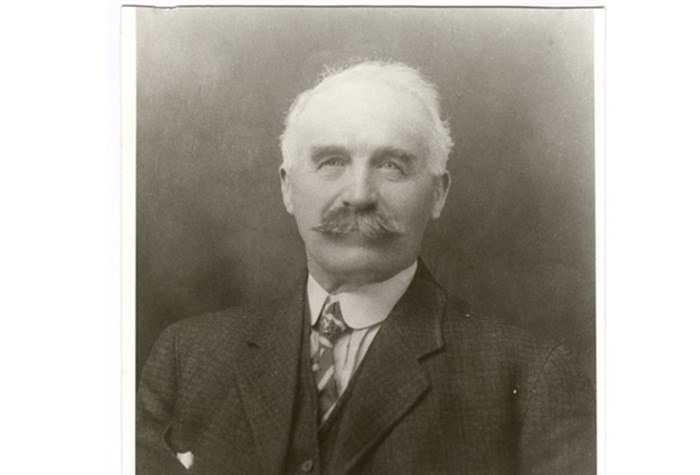
Cornelius O'Keefe is just one of the influential Irishman who shaped the Okanagan.
Image Credit: Historic O'Keefe Ranch Collection 015
March 17, 2024 - 6:00 PM
From the most prominent landowners to the namesake of the City of Vernon, here’s how Irish settlement transformed the Okanagan.
“The Irish have contributed a huge amount and wielded a lot of power in their days,” Bob Hayes, president of the Okanagan Historical Society, told iNFOnews.ca.
Some the most influential Irishmen in the Okanagan were Charles and Forbes Vernon, after whom the City of Vernon was named.
According to documents from the Okanagan Historical Society, the Vernon brother’s, whose father was J.E. Venables Vernon of Clontarf Castle in Ireland, owned the then 13,000-acre Coldstream Ranch.
The Vernon brothers were influential and wealthy and Forbes Vernon was a member of the provincial government.
Another famous rancher in the region, who also happened to be of Irish decent, was Cornelius O'Keefe, the owner of O’Keefe Ranch.
READ MORE: How to inherit a $28M property: The story behind the O'Keefe Range
O'Keefe arrived in 1867 and like many other settlers at the time acquired his first chunk of Indigenous land for free.
“He came here with some money,” Hayes said. “You could always acquire 160 acres free. That was preemption. But then you could buy extra.”
Settlers from all backgrounds took advantage of the preemption rule as a way of establishing themselves in the Okanagan.
“You had to live on the land and you had to improve it. Which meant fence it, build a house on it, farm a ranch on it,” Hayes said. “And after seven years of this… it was called proving of the property, it was yours, free.”
Irish landowners like Tom Ellis, Cornelius O'Keeffe, Charles Houghton and Judge Hansen, were some of the most prominent in the region.
READ MORE: The lonely namesake of Knox Mountain
“The Irish that were here tended to all be landowners,” Hayes said. “There weren't a lot of Irish who were here maybe making shoes or whatever. No, they were here and they were established as ranchers, starting from the 1860s.”
Many of these Irishmen would typically come to Canada with a letter of introduction from the Irish government, before establishing themselves as landowners and cattle ranchers.
Cattle ranching was the first big industry in the Okanagan, before it was discovered in the late 1800s that the land was better suited to fruit growing.
“In Penticton, the biggest landowners of all, by far and away, were both Irish,” Hayes said. “Judge Haynes. He had a huge ranch in Oliver, Osoyoos. We're talking like tens of thousands of acres. And then the biggest landowner, because he ended up taking over Haynes' land, was Tom Ellis.”
“Tom Ellis, I think, by the end of it, had over 20,000 acres,” Hayes said. “Ellis owned basically what's all of now downtown Penticton and Ellis Street here in Kelowna is named after him.”
READ MORE: From 700 to 150,000: How Kelowna's population exploded in a century
Ellis is a powerful and influential figure in Okanagan history, namely because of his ruthless methods of acquiring property.
“Judge Haynes had been his former friend and partner,” Hayes said. “And when Judge Haynes died, the ranch went into receivership, this was in the late 1880s, Tom Ellis acquired it for pennies on the dollar from his former friend, now deceased, and kicked the Haynes family off of the ranch and said, ‘that's mine now, thank you very much’.”
On the other hand, there were prominent Irishmen who had a profoundly positive impact on locals.
One of those men was Archdeacon Thomas Greene, a prominent clergyman in the region in the late 19th to early 20th century.
“He's the one who brought Anglicanism to the valley,” Hayes said. “If you go to St. Michael's Cathedral there's a view of the main window that's dedicated to him. He was a giant here.”
READ MORE: How Pandosy's mission inadvertently made the Okanagan a wine capital
According to Hayes, by all accounts, Greene was a highly respected figure.
During the 1918 Spanish Influenza pandemic, Chinatown was one of the worst effect communities.
Despite the area being under a strict quarantine, Greene visited the residents while knowing he wouldn’t be able to leave until the quarantine was lifted.
As recognition of his service, the Chinese community gave Greene a special award and thanked him for helping the community when others had turned their back on them.
Other prominent men bought Irish culture and tradition, like Joseph Christien who introduced step dancing and Irish music to the region.
These traditions were particularly prominent in the Ellison area of Kelowna, where a large portion of Irish immigrants settled.
“Even George Whelan, my great-great-grandfather, he was of Irish descent,” Hayes said. “He was the largest landowner in Ellison. He had about 3,000 acres.”
According to Hayes, there was a strong recognition in the early days of settlement “that the Irish were here, and they were not going to be pushed away.”
To contact a reporter for this story, email Georgina Whitehouse or call 250-864-7494 or email the editor. You can also submit photos, videos or news tips to the newsroom and be entered to win a monthly prize draw.
We welcome your comments and opinions on our stories but play nice. We won't censor or delete comments unless they contain off-topic statements or links, unnecessary vulgarity, false facts, spam or obviously fake profiles. If you have any concerns about what you see in comments, email the editor in the link above. SUBSCRIBE to our awesome newsletter here.
News from © iNFOnews, 2024